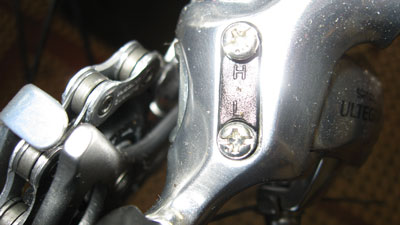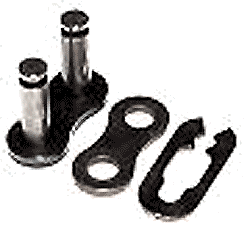 A rear derailleur is designed to move (or derail) a chain from one sprocket to the next. It pushes the chain sideways, so that it runs at an angle onto the sprocket, instead of straight. When the angle becomes sharp enough, the chain can no longer mesh with the sprocket. It then falls off the sprocket and lands on the one next in line. When the chain is being shifted from a smaller sprocket to a larger one, the chain will rub on the side of the larger sprocket until it gets snagged onto its teeth. It is composed of two pulleys (upper is guide pulley, lower is tension pulley) in a spring-loaded rotating cage, through which the chain rolls in an S-shaped pattern.
A rear derailleur is designed to move (or derail) a chain from one sprocket to the next. It pushes the chain sideways, so that it runs at an angle onto the sprocket, instead of straight. When the angle becomes sharp enough, the chain can no longer mesh with the sprocket. It then falls off the sprocket and lands on the one next in line. When the chain is being shifted from a smaller sprocket to a larger one, the chain will rub on the side of the larger sprocket until it gets snagged onto its teeth. It is composed of two pulleys (upper is guide pulley, lower is tension pulley) in a spring-loaded rotating cage, through which the chain rolls in an S-shaped pattern.For the common rear derailleur, increasing inner wire tension moves the rear derailleur to the left (towards the spokes). Decreasing inner wire tension moves the derailleur to the right. For instance, when you climb a hill and switch to a lower gear, you pull the shift cable to force the pulley to change to a bigger sprocket.

The derailleur body is fitted with a spring that is pulled tight or relaxed by the inner wire. Pulling the inner wire tightens the spring and moves the cage/pulley to the left.
Adjusting the Rear Derailleur: Limit Stops
 The limit stops/screws set the limits of how far the derailleur can move from left to right, but are not intended to move the derailleur. Loosening a limit allows the derailleur to be moved farther in a certain direction whereas tightening a limit restricts its motion. The ends of the screws bump into internal parts of the parallelogram when the derailleur has moved all the way in the direction controlled by that screw. Turn clockwise to tighten and counterclockwise to loosen.
The limit stops/screws set the limits of how far the derailleur can move from left to right, but are not intended to move the derailleur. Loosening a limit allows the derailleur to be moved farther in a certain direction whereas tightening a limit restricts its motion. The ends of the screws bump into internal parts of the parallelogram when the derailleur has moved all the way in the direction controlled by that screw. Turn clockwise to tighten and counterclockwise to loosen.- High Gear Limit Stop
- In order to adjust it properly, there must be no tension on the lower inner cable. If you feel tension, loosen the cable adjuster (turn it clockwise) until there is none.
- When adjusting, check for two solutions:
- The outward shift from the second sprocket to the outermost sprocket
- How the chain rides on the outermost sprocket
- Proper adjustment: When H-screw is at its tightest acceptable setting
 Modern derailleurs have 2 spring-loaded pivots. The lower pivot winds the cage up to take up slack as you go to smaller sprockets. The upper pivot, controlled by the b-screw, adds additional slack take-up ability by pushing the derailleur's parallelogram backwards. The tension of the two springs needs to be balanced for best shifting.
Modern derailleurs have 2 spring-loaded pivots. The lower pivot winds the cage up to take up slack as you go to smaller sprockets. The upper pivot, controlled by the b-screw, adds additional slack take-up ability by pushing the derailleur's parallelogram backwards. The tension of the two springs needs to be balanced for best shifting.The B-screw controls the derailleur's body angle in relation to the sprocket set. This screw adjusts the tension of the upper spring/pivot of the parallelogram and thus, the height of the jockey pulley. The looser this screw is, the closer the jockey pulley will be to the cluster.
Since a derailleur shift is caused by forcing the chain to run at an angle, the greater the angle,
the sooner it will shift. The closer the jockey pulley is to the cluster, the sharper the angle will
be for a given amount of sideways motion of the derailleur. Thus, the looser the b-screw is, the better the shifting will be.
Indexing Adjustmentthe sooner it will shift. The closer the jockey pulley is to the cluster, the sharper the angle will
be for a given amount of sideways motion of the derailleur. Thus, the looser the b-screw is, the better the shifting will be.
- Shift down to the innermost rear cog (lowest gear) and innermost front cog (smallest chainring) and check the distance between the guide pulley and the largest sprocket.
- If the pulley is rubbing against the cog, tighten the B-screw (clockwise) to increase tension which will move the pulley away from the sprocket.
- If there is a large gap between the pulley and sprocket, loosen the B-screw until the pulley rubs the sprocket and then tighten it until it just clears.
 The rear derailleur indexing is adjusted by changing the inner wire tension at the adjusting barrel. For common rear derailleurs, increasing wire tension (counter-clockwise) moves the derailleur to the left. Decreasing wire tension (clockwise) moves it to the right. (Shimano or "Low Normal" derailleurs operate differently)
The rear derailleur indexing is adjusted by changing the inner wire tension at the adjusting barrel. For common rear derailleurs, increasing wire tension (counter-clockwise) moves the derailleur to the left. Decreasing wire tension (clockwise) moves it to the right. (Shimano or "Low Normal" derailleurs operate differently)The goal of adjusting indexing is to find the tightest inner wire tension that will allow good shifting to the gears normally used. This will allow the longest lasting indexing adjustment as the system wears and the cable system stretches with use. To find the tightest inner wire setting, you will purposely make the setting too tight then relax the tension slightly.
Two basic symptoms for a "too tight" inner wire:
- A rattling noise from the chain rubbing against the next cog inward
- A slow or hesitant outward shift
































